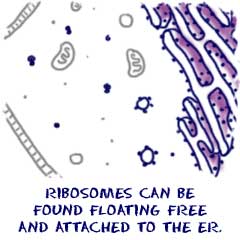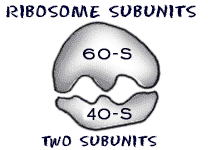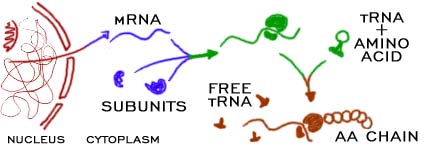
Ribosomes - Protein Construction Teams
Cells need to make proteins. Enzymes made of proteins are used to help speed up biological processes. Other proteins support cell functions and are found embedded in membranes. Proteins even make up most of your hair. When a cell needs to make proteins, it looks for ribosomes. Ribosomes are the protein builders or the protein synthesizers of the cell. They are like construction guys who connect one amino acid at a time and build long chains. Ribosomes are special because they are found in both prokaryotes and eukaryotes. While a structure such as a nucleus is only found in eukaryotes, every cell needs ribosomes to manufacture proteins. Since there are no membrane-bound organelles in prokaryotes, the ribosomes float free in the cytosol.
Ribosomes are special because they are found in both prokaryotes and eukaryotes. While a structure such as a nucleus is only found in eukaryotes, every cell needs ribosomes to manufacture proteins. Since there are no membrane-bound organelles in prokaryotes, the ribosomes float free in the cytosol.
Ribosomes are found in many places around a eukaryotic cell. You might find them floating in the cytosol. Those floating ribosomes make proteins that will be used inside of the cell. Other ribosomes are found on the endoplasmic reticulum. Endoplasmic reticulum with attached ribosomes is called rough ER. It looks bumpy under a microscope. The attached ribosomes make proteins that will be used inside the cell and proteins made for export out of the cell. There are also ribosomes attached to the nuclear envelope. Those ribosomes synthesize proteins that are released into the perinuclear space.
Two Pieces Make the Whole
 There are two pieces or subunits to every ribosome. In eukaryotes, scientists have identified the 60-S (large) and 40-S (small) subunits. Even though ribosomes have slightly different structures in different species, their functional areas are all very similar.
There are two pieces or subunits to every ribosome. In eukaryotes, scientists have identified the 60-S (large) and 40-S (small) subunits. Even though ribosomes have slightly different structures in different species, their functional areas are all very similar.
For example, prokaryotes have ribosomes that are slightly smaller than eukaryotes. The 60-S/ 40-S model works fine for eukaryotic cells while prokaryotic cells have ribosomes made of 50-S and 30-S subunits. It's a small difference, but one of many you will find in the two different types of cells. Scientists have used this difference in ribosome structure to develop drugs that can kill prokaryotic microorganisms which cause disease. There are even structural differences between ribosomes found in the mitochondria and free ribosomes.
Mixing and Matching Amino Acids

When are ribosomes used in the process of protein synthesis? When the cell needs to make a protein, mRNA is created in the nucleus. The mRNA is then sent out of the nucleus and to the ribosomes. When it is time to make the protein, the two subunits come together and combine with the mRNA. The subunits lock onto the mRNA and start the protein synthesis.
The process of making proteins is quite simple. First, you need an amino acid. Another nucleic acid that lives in the cell is transfer RNA. tRNA is bonded to the amino acids floating around the cell. With the mRNA offering instructions, the ribosome connects to a tRNA and pulls off one amino acid. The tRNA is then released back into the cell and attaches to another amino acid. The ribosome builds a long amino acid (polypeptide) chain that will eventually be part of a larger protein.
► NEXT PAGE ON CELL STRUCTURE
► NEXT STOP ON SITE TOUR
► RETURN TO TOP OF PAGE
► Or search the sites...
► NEXT STOP ON SITE TOUR
► RETURN TO TOP OF PAGE
► Or search the sites...
Related Video...
Brain Cells from Skin Cells (Cambridge University Video)
Encyclopedia.com:
http://www.encyclopedia.com/topic/Ribosomes.aspx
Wikipedia:
http://en.wikipedia.org/wiki/Ribosomes
Encyclopædia Britannica:
http://www.britannica.com/EBchecked/topic/502164/ribosome



